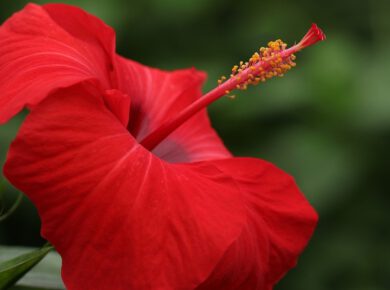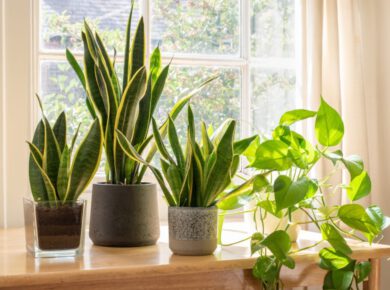Table of Contents Show
Money plants, also known as jade plants or Crassula ovata, are common indoor plants that are loved for their toughness and beauty. In this guide, we will provide you with detailed instructions on how to grow and take care of a money plant in water or soil and give some tips on how to keep it healthy.
How to Grow Money Plants in Water
Growing money plants in water is easy and can be a fun experience. Below is the step-by-step procedure:
Materials You Will Need
- Healthy stem cutting
- Glass jar or container
- Clean fresh water at room temperature
- Rooting hormone (optional)
- Seaweed fertilizer (optional)
Step-by-Step Instructions
Take Stem Cuttings: Use sharp scissors or pruning shears to cut off a healthy branch with several leaf nodes from the money plant.
Remove Extra Leaves: Strip off the leaves from the lower part of the cutting, leaving at least two stem nodes exposed.
Add Rooting Hormone (Optional): Dip the cut end of the stem into the rooting hormone to speed up root development.
Place the Cuttings in Water: Fill a glass jar with clean, fresh water at room temperature and place the stem cutting inside, making sure that the nodes are submerged
Position the Jar: Put the jar in a spot that receives bright but indirect sunlight; direct sunlight may harm the plant.
Maintain the Water: Change the water at least once every week to ensure enough fresh oxygen flows through it. You can also add seaweed fertilizer for faster growth.
Pros and Cons of Growing in Water
Benefits:
Easy Monitoring: It is easy to monitor root development as well as levels of water when growing in water.
Aesthetically Pleasing: Having a money plant in a glass jar can add beauty to your home decor.
Drawbacks:
Limited Nutrient Supply: Water does not contain as many nutrients as soil, so you might need to supplement it with fertilizers.
Root Rot Risk: If the water is not changed regularly, roots may rot due to a lack of oxygen.
How to Care for a Money Plant
Caring for a money plant involves providing favorable growing conditions and regular maintenance. Here’s what you should do:
Ideal Growing Conditions
Soil Type: Use a well-draining, nutrient-rich potting mix; one with high peat moss content or specifically made-for-money plants will be best.
Watering Schedule: Water the plant when the top inch of soil is dry. Ensure that the pot has drainage holes to prevent waterlogging. Reduce watering during winter.
Sunlight Requirements: It does well in bright, indirect sun. To avoid direct sunlight that could burn leaves, place them in a spot where they receive filtered light instead.
Temperature Range: It thrive at temperatures between 65-80°F (18-27°C).
Humidity: Aim for a humidity level of around 50%; if the air is too dry, consider using a humidifier or misting it.
Seasonal Adjustments: Do not put the plant in direct sunlight during summer; conversely, moving closer to a light source may be necessary during winter when daylight is shorter.
Indoor Placement: For gentle morning sun without harsh midday rays, consider north or east-facing windows ideal.
Maintenance Tips
Pruning: Trim back in spring to keep its shape and promote new growth; remove any yellow or dead leaves by hand.
Fertilizing: Feed with balanced water-soluble fertilizer 3-4 times per year.
Troubleshooting Common Issues:
Yellow Leaves: Overwatering or too much light can cause this. Change the watering frequency and move to a location with indirect sunlight.
Pests: Aphids and scales are common pests for money plants. Neem oil can help control these problems.
Money Plant Varieties
There are many different types of money plants, each with distinct features and care needs. Here are some popular varieties:
Green Money Plant: The green is the most common type of money plant. It has bright green leaves and is often seen in households worldwide.
Variegated or Gold King: This variety resembles the green money plant, but its leaves have a slight gold variegation.
Pilea peperomioides (Chinese Money Plant): Commonly known as the Chinese Money Plant or Pancake Plant, this plant has round, coin-shaped leaves and is said to attract wealth and positive energy.
Monstera (Split Leaf Money Plant): Also called Monstera deliciosa, this kind of money plant has large lobate leaves with unique cuts. It can tolerate drought and low light conditions.
Epipremnum aureum (Golden Pothos): Golden Pothos is a popular variety of money plants with heart-shaped leaves that are golden or yellowish. It is famous for its air-purifying abilities
Epipremnum aureum ‘Manjula’: Manjula Pothos is a specific type of Golden Pothos with green leaves with creamy-white variegation. It can adapt to different indoor environments and is suitable for beginners.
Epipremnum aureum ‘Pearls and Jade’: This unusual Golden Pothos variant features green leaves speckled with white and cream-colored spots, adding excitement to your collection of money plants.
Epipremnum aureum ‘Neon’: Neon Pothos is an eye-catching variety characterized by bright neon green foliage that can liven up any space.
Epipremnum aureum ‘Marble Queen’: Marble Queen Pothos has dark green leaves with a touch of golden-yellow variegation, making it an interesting addition to your money plant collection.
Epipremnum aureum ‘Jade’: Jade Pothos has shiny dark green leaves with wavy edges, which makes it a great choice for a money plant in your house.
These are just a few examples of the many types of money plants you can choose from. Each variety is beautiful and brings nature’s abundance into your home.
Recommendations for Beginners
Crassula ovata – Highly resilient variety tolerates wide range of conditions making them perfect for newbies!
Pilea peperomioides- Its unusual look along with ease in propagation makes this one the best choice for any starter at plant caring!
Conclusion
Growing and tending to your own money plant can prove very fulfilling, so just give it a try! Whether you decide on water or soil growth methods, a proper environment coupled with regular upkeep will ensure success in raising healthy plants every single time. This green beauty requires minimal effort while yielding maximum results, hence why many people love having them around their living spaces.
Follow the advice in this guide, and soon enough, even the most inexperienced individuals will become masters of nurturing these vibrant beauties.


